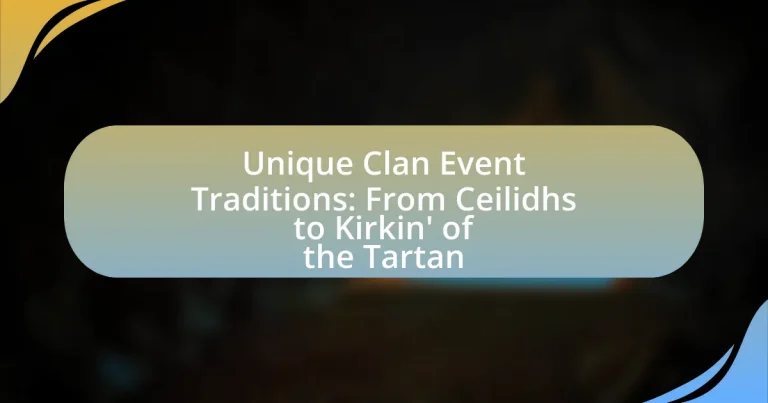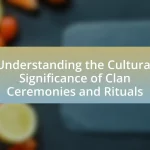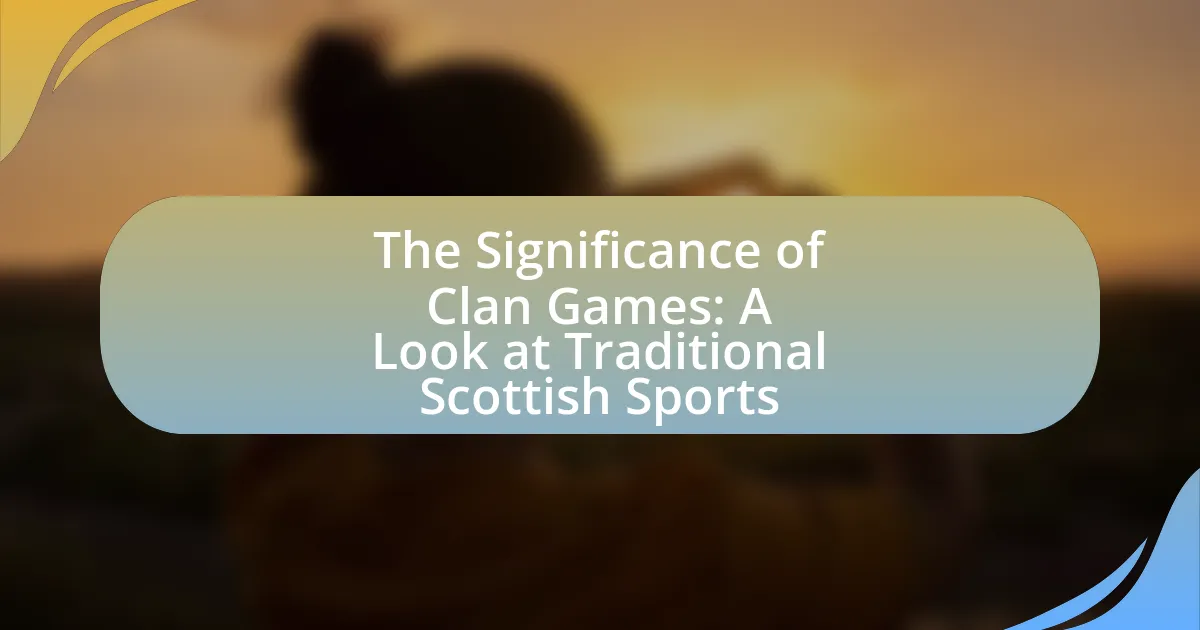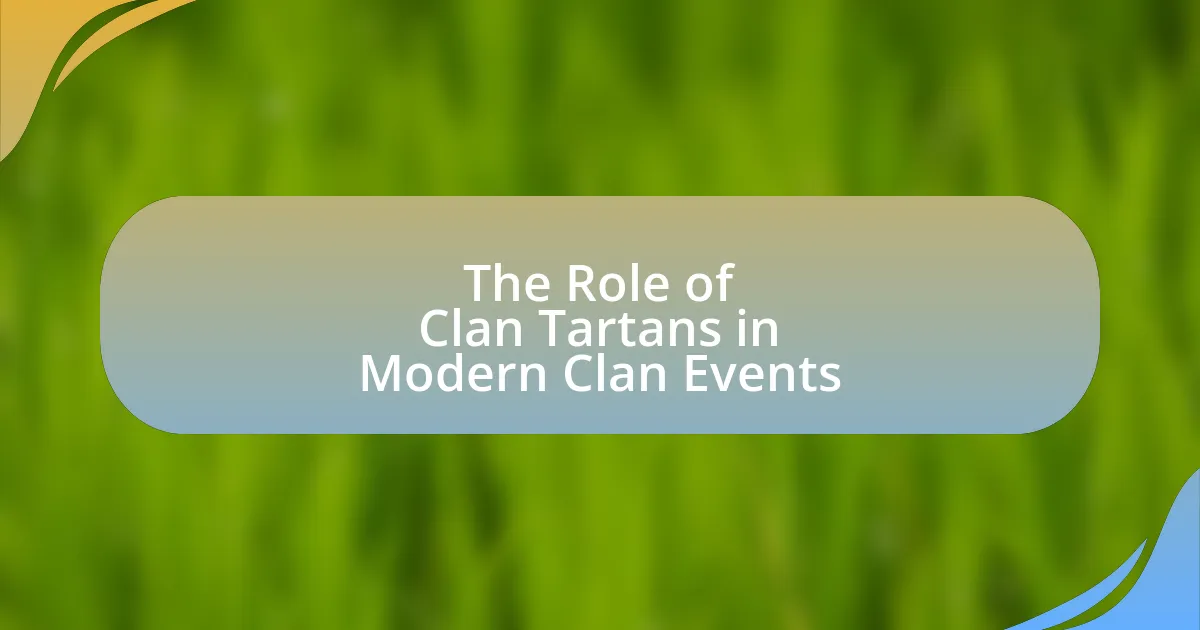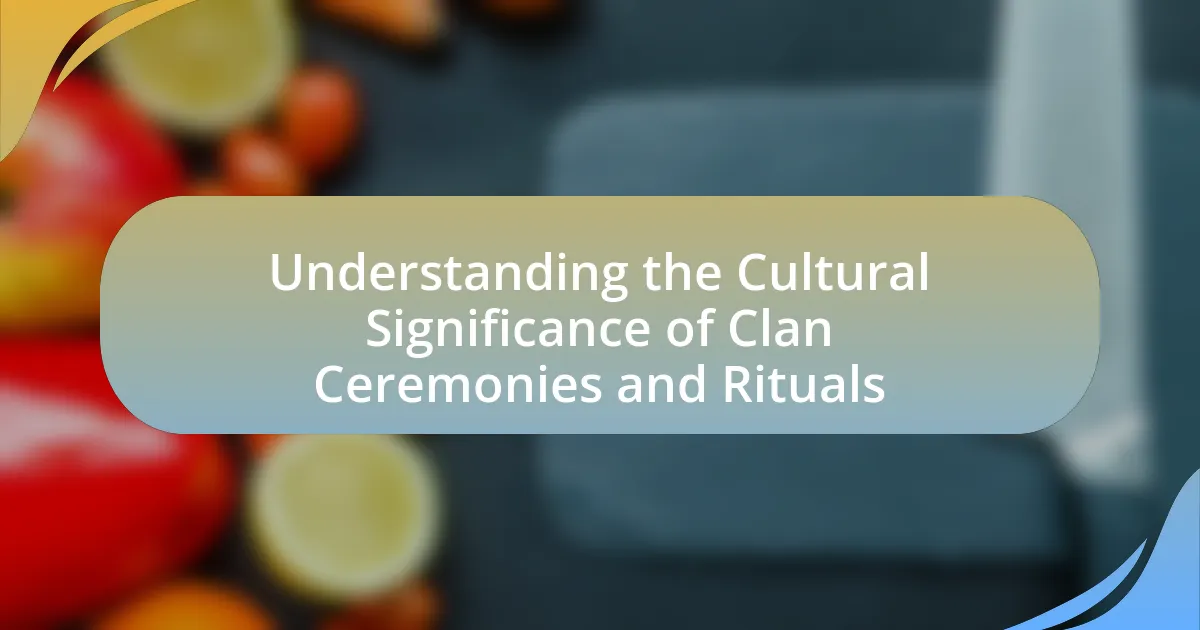Unique clan event traditions, such as ceilidhs and the Kirkin’ of the Tartan, play a significant role in celebrating Scottish heritage and fostering community bonds. Ceilidhs are traditional gatherings that emphasize music, dance, and storytelling, reinforcing clan identity and continuity. The Kirkin’ of the Tartan serves as a ceremonial blessing of clan tartans, symbolizing pride in heritage and unity among clan members. These traditions not only preserve cultural practices but also enhance social cohesion and intergenerational connections within Scottish communities. The article explores the historical context, significance, and unique elements of these traditions, highlighting their importance in maintaining clan identity and cultural heritage.
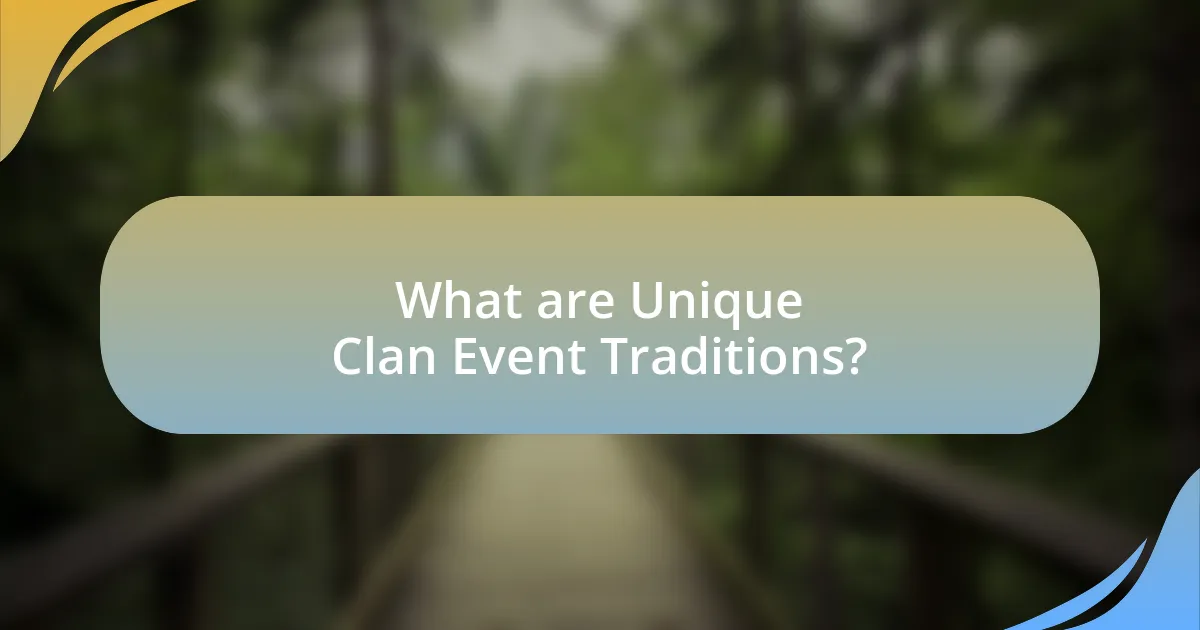
What are Unique Clan Event Traditions?
Unique clan event traditions encompass a variety of cultural practices that celebrate heritage and community, such as ceilidhs and the Kirkin’ of the Tartan. Ceilidhs are traditional Scottish social gatherings featuring music and dancing, often held to strengthen clan bonds and celebrate significant events. The Kirkin’ of the Tartan is a ceremonial event where clan members wear their tartans to church, symbolizing pride in their heritage and unity within the clan. These traditions serve to reinforce identity and foster connections among members, reflecting the historical significance of clans in Scottish culture.
How do these traditions reflect clan identity?
Clan traditions, such as ceilidhs and the Kirkin’ of the Tartan, reflect clan identity by reinforcing shared values, history, and social bonds among members. These events serve as cultural touchstones that celebrate lineage and heritage, fostering a sense of belonging and continuity within the clan. For instance, ceilidhs, which are traditional Scottish gatherings featuring music and dance, promote communal participation and storytelling, thereby preserving clan narratives and strengthening interpersonal connections. Similarly, the Kirkin’ of the Tartan, a ceremonial blessing of clan tartans, symbolizes pride in clan identity and heritage, linking members to their ancestral roots. Such traditions not only celebrate individual clans but also contribute to the broader cultural landscape, highlighting the importance of collective identity in maintaining clan cohesion.
What elements contribute to the uniqueness of these traditions?
The elements that contribute to the uniqueness of clan event traditions, such as ceilidhs and the Kirkin’ of the Tartan, include cultural heritage, community participation, and distinctive rituals. Cultural heritage is reflected in the music, dance, and storytelling that characterize ceilidhs, which celebrate Scottish history and identity. Community participation is essential, as these events often involve local members coming together to share in the festivities, reinforcing social bonds. Distinctive rituals, such as the Kirkin’ of the Tartan, which blesses clan tartans in a church service, highlight specific clan identities and traditions, making each event unique to its cultural context. These elements collectively ensure that such traditions are not only preserved but also celebrated in a way that honors their historical significance.
How do historical events shape these clan traditions?
Historical events significantly shape clan traditions by influencing cultural practices, rituals, and communal identities. For instance, the Jacobite uprisings in the 18th century led to the revival of Scottish clan traditions, including ceilidhs, as a means of preserving cultural heritage and fostering unity among clan members. Additionally, the Kirkin’ of the Tartan ceremony emerged as a response to the banning of tartan after the Battle of Culloden, symbolizing resilience and the enduring spirit of Scottish clans. These events directly impacted how clans celebrate their history and maintain their unique identities through specific traditions.
Why are clan events significant in Scottish culture?
Clan events are significant in Scottish culture because they serve as a vital means of preserving and celebrating heritage, identity, and community among Scots. These gatherings, such as ceilidhs and the Kirkin’ of the Tartan, foster a sense of belonging and continuity, allowing individuals to connect with their ancestral roots and clan history. Historically, clan events have been instrumental in maintaining traditions, showcasing Scottish music, dance, and storytelling, which are essential components of cultural identity. Furthermore, these events often involve rituals and ceremonies that reinforce social bonds and collective memory, making them a cornerstone of Scottish cultural expression.
What role do clan events play in community bonding?
Clan events play a crucial role in community bonding by fostering a sense of belonging and shared identity among participants. These gatherings, such as ceilidhs and kirkin’ of the tartan, provide opportunities for individuals to connect through cultural traditions, shared experiences, and collective participation in rituals. Research indicates that communal activities enhance social cohesion, as they encourage interaction and collaboration, reinforcing relationships within the community. For example, clan events often involve music, dance, and storytelling, which serve to strengthen ties and create lasting memories among attendees, thereby solidifying the community’s unity and cultural heritage.
How do clan events preserve cultural heritage?
Clan events preserve cultural heritage by actively engaging community members in traditional practices, rituals, and storytelling that reflect their historical identity. These gatherings, such as ceilidhs and Kirkin’ of the Tartan, serve as platforms for passing down customs, music, dance, and language, ensuring that younger generations remain connected to their ancestry. For instance, ceilidhs often feature traditional Scottish music and dance, which not only entertain but also educate participants about their cultural roots. Additionally, events like the Kirkin’ of the Tartan symbolize the importance of clan tartans and their historical significance, reinforcing a sense of belonging and continuity within the community.

What are Ceilidhs and their significance?
Ceilidhs are traditional Scottish social gatherings that involve music, dancing, and storytelling. They serve as a vital cultural expression, fostering community bonds and preserving Scottish heritage. Historically, ceilidhs originated in rural Scotland as informal gatherings where people would come together to celebrate significant events, such as weddings or harvests, often featuring folk music and traditional dances like the Highland Fling. The significance of ceilidhs lies in their role as a means of cultural transmission, allowing generations to connect through shared customs and practices, thereby reinforcing community identity and continuity.
How do Ceilidhs differ from other social gatherings?
Ceilidhs differ from other social gatherings primarily through their emphasis on traditional Scottish music and dance, creating a participatory atmosphere. Unlike typical social events that may focus on conversation or dining, ceilidhs involve structured group dances, often led by a caller, encouraging everyone to join in regardless of skill level. This communal aspect fosters a sense of unity and celebration, which is distinct from more formal or passive social gatherings. Historically, ceilidhs have served as a means of cultural expression and community bonding, particularly in Scottish heritage, where they have been integral to social life for centuries.
What activities are typically included in a Ceilidh?
A Ceilidh typically includes traditional Scottish dancing, live music, and socializing. The dancing often features group dances such as the Strip the Willow and the Gay Gordons, which are led by a caller to guide participants. Live music is usually provided by a band playing folk instruments like fiddles, accordions, and drums, creating an energetic atmosphere. Additionally, Ceilidhs often involve storytelling and singing, further enriching the cultural experience. These activities are rooted in Scottish heritage and are designed to foster community and celebration.
How do Ceilidhs promote traditional music and dance?
Ceilidhs promote traditional music and dance by serving as communal gatherings where participants engage in folk music and dance forms that have been passed down through generations. These events feature live performances of traditional instruments, such as fiddles and accordions, which create an authentic atmosphere that encourages attendees to participate in dances like the ceilidh dance, fostering a sense of cultural identity and continuity. Historical records indicate that ceilidhs have been integral to Scottish and Irish culture since at least the 18th century, highlighting their role in preserving and revitalizing traditional art forms within communities.
Why are Ceilidhs important for clan unity?
Ceilidhs are important for clan unity because they serve as communal gatherings that reinforce social bonds among clan members. These events facilitate interaction through traditional music, dance, and storytelling, which are integral to clan identity. Historical evidence shows that ceilidhs have been a longstanding practice in Scottish culture, promoting a sense of belonging and shared heritage, thus strengthening familial ties and collective identity within clans.
How do Ceilidhs foster intergenerational connections?
Ceilidhs foster intergenerational connections by providing a communal space where individuals of all ages can engage in traditional music and dance. This inclusive environment encourages participation from children, parents, and grandparents, allowing them to share experiences and cultural heritage. The interactive nature of ceilidh activities, such as group dances and storytelling, promotes bonding and understanding across generations. Research indicates that such communal events enhance social cohesion and strengthen familial ties, as they create shared memories and foster a sense of belonging within the community.
What are some notable Ceilidh events in Scotland?
Notable Ceilidh events in Scotland include the Edinburgh Ceilidh, which takes place regularly at various venues and features traditional Scottish music and dance. Another significant event is the Hebridean Celtic Festival, held annually in Stornoway, showcasing local and international artists alongside traditional ceilidh dancing. The Skye Festival, also known as Fèis an Eilein, offers a week of music, dance, and workshops, culminating in ceilidh nights that celebrate Scottish culture. These events are recognized for their role in preserving and promoting Scottish heritage through communal dancing and music.
What is the Kirkin’ of the Tartan?
The Kirkin’ of the Tartan is a ceremonial event in which Scottish clans bless their tartans during a church service. This tradition, which originated in the 16th century, symbolizes the connection between the clan’s heritage and faith. The event often includes the display of clan tartans, prayers, and hymns, reinforcing the cultural significance of tartan as a symbol of Scottish identity.
How did the Kirkin’ of the Tartan originate?
The Kirkin’ of the Tartan originated as a Scottish Presbyterian tradition in the 16th century, intended to honor the Scottish clans and their tartans during church services. This practice emerged as a way to celebrate Scottish heritage and identity, particularly after the Jacobite uprisings, when wearing tartan was banned. The Kirkin’ of the Tartan symbolizes the connection between faith and clan, allowing individuals to bring their tartans to church for a blessing, reinforcing the importance of both cultural and spiritual identity in Scottish society.
What is the historical context behind the Kirkin’ of the Tartan?
The Kirkin’ of the Tartan originated in the 18th century as a response to the suppression of Scottish culture following the Jacobite uprisings. This event symbolizes the revival of Scottish identity and heritage, particularly after the 1746 Act of Proscription, which banned the wearing of tartan and the carrying of weapons. The Kirkin’ serves as a church service where tartan is blessed, reflecting the deep connection between Scottish clans and their ancestral patterns, and it has become a significant cultural celebration that emphasizes pride in Scottish heritage.
How has the Kirkin’ of the Tartan evolved over time?
The Kirkin’ of the Tartan has evolved from a traditional Scottish church service into a modern celebration of Scottish heritage and identity. Initially, the event served as a way to bless the tartans worn by clan members during church services, symbolizing a connection to their ancestry. Over time, particularly in the 20th century, the Kirkin’ of the Tartan transformed into a more public and festive occasion, often incorporating music, dance, and community gatherings, reflecting a broader celebration of Scottish culture. This evolution is evidenced by the increasing participation of various clans and the inclusion of cultural performances, making it a significant event in contemporary Scottish society.
What role does the Kirkin’ of the Tartan play in modern clan events?
The Kirkin’ of the Tartan serves as a ceremonial blessing of clan tartans during modern clan events, symbolizing unity and heritage. This tradition, which originated in the 16th century, has evolved to reinforce clan identity and foster community spirit among members. By incorporating the Kirkin’ into events such as clan gatherings and festivals, clans honor their ancestral ties and promote cultural continuity, making it a significant aspect of contemporary Scottish heritage celebrations.
How do clans incorporate the Kirkin’ of the Tartan into their celebrations?
Clans incorporate the Kirkin’ of the Tartan into their celebrations by holding a ceremonial blessing of their tartans during church services or clan gatherings. This tradition emphasizes the significance of tartan as a symbol of clan identity and heritage. During the Kirkin’, clan members often wear their tartans and participate in a service that includes prayers and hymns, reinforcing their connection to their ancestry and community. The practice is rooted in Scottish history, where it was believed that the tartan represented the spirit of the clan, thus making the blessing a vital part of clan celebrations.
What are the key rituals associated with the Kirkin’ of the Tartan?
The key rituals associated with the Kirkin’ of the Tartan include the blessing of tartan cloth, the presentation of clan banners, and the wearing of tartan by attendees. During the ceremony, a minister typically blesses the tartan, symbolizing the connection between the clan and their heritage. Clan members often bring their family tartans to be blessed, reinforcing their identity and unity. The event usually features a procession where clan banners are displayed, highlighting the significance of each clan’s history and lineage. These rituals collectively celebrate Scottish heritage and foster a sense of community among participants.
How can clans effectively celebrate their traditions?
Clans can effectively celebrate their traditions by organizing events that incorporate cultural practices, rituals, and community participation. For instance, hosting ceilidhs, which are traditional Scottish social gatherings featuring music and dance, allows clans to engage members and share their heritage. Additionally, events like the Kirkin’ of the Tartan, where clan members wear their tartans in a ceremonial church service, reinforce identity and unity. Historical evidence shows that such gatherings not only preserve cultural heritage but also strengthen clan bonds, as seen in the annual Clan Gathering in Scotland, which attracts thousands and showcases traditional customs.
What best practices should clans follow when organizing events?
Clans should follow structured planning, clear communication, and community engagement as best practices when organizing events. Structured planning involves setting a timeline, budget, and specific roles for members to ensure all aspects of the event are covered. Clear communication is essential for informing clan members about event details, responsibilities, and updates, which can be facilitated through group chats or newsletters. Community engagement encourages participation and fosters a sense of belonging, which can be achieved by involving members in decision-making and promoting the event through social media and local networks. These practices enhance organization and participation, leading to successful clan events.
How can clans engage younger generations in these traditions?
Clans can engage younger generations in these traditions by incorporating modern technology and social media to promote events and share cultural stories. For instance, clans can create interactive online platforms where younger members can participate in virtual ceilidhs or share their experiences related to the Kirkin’ of the Tartan. Research indicates that 70% of millennials are more likely to engage with cultural traditions that utilize digital storytelling, making it essential for clans to adapt their outreach methods. By blending traditional practices with contemporary communication tools, clans can foster a sense of belonging and encourage active participation among younger generations.
